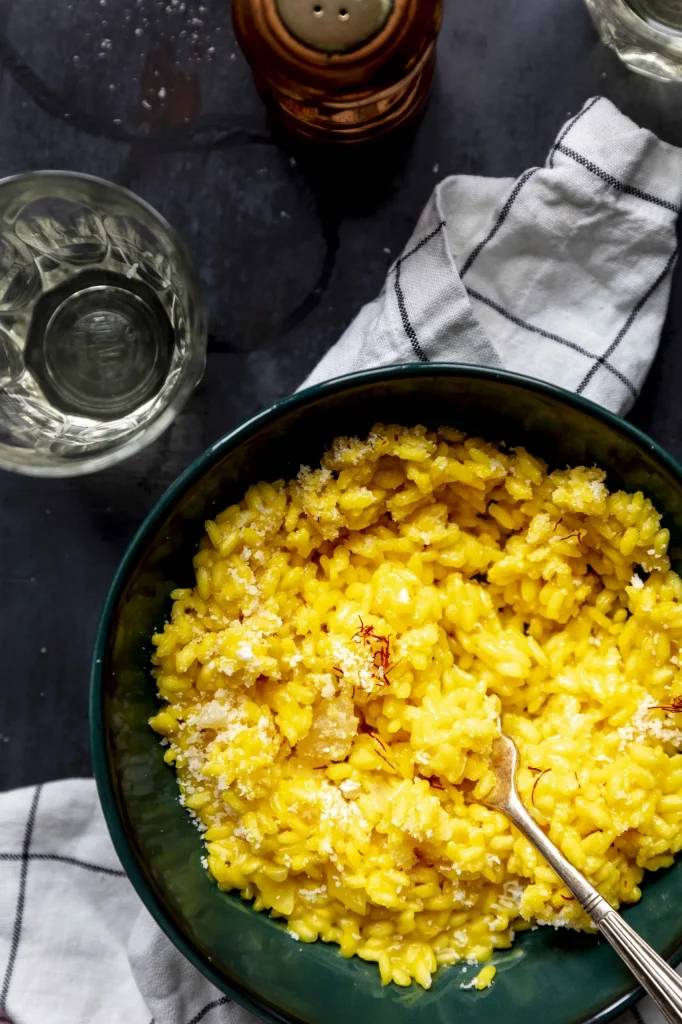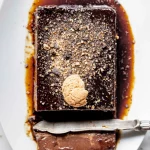Creamy, rich Risotto Milanese from Milan is like receiving a big, warm, comforting hug. It is a bit laborious to make, but it is worth the effort. This recipe reminds me of my childhood when my dad used to cook risotto on Sundays. It comes from Lombardy, in the north of Italy where my dad was born and where this is a typical Sunday dish. It takes quite a long time to prepare, so slow down and enjoy this magnificent dish.
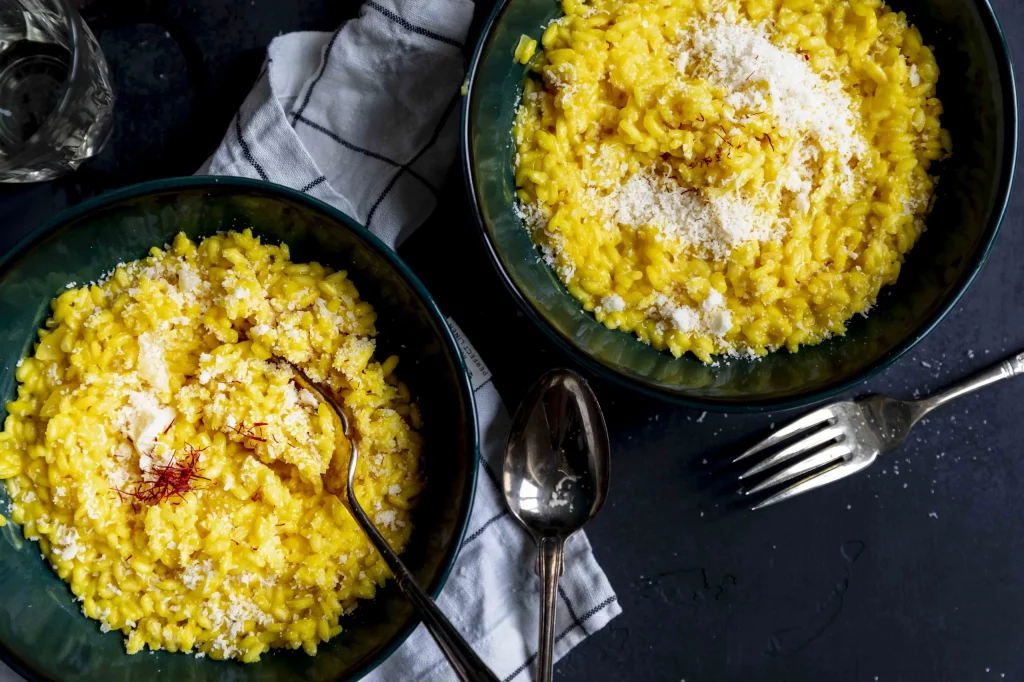
Where does risotto originally come from?
Several interesting anecdotes and intriguing stories surround Risotto Milanese. According to the most famous one, it was created in 1574 as a joke which took place at the wedding reception of the daughter of a Flemish painter who was working on the glass windows in the Duomo, the cathedral, of Milan. The legend says that Zafferano (saffron in Italian) the painter’s assistant would add some spices to his colors to make them brighter. During the wedding reception, as a joke, Zafferano convinced the cook to put some saffron into the risotto which, at that time, was only seasoned with butter. The guests showed great appreciation since saffron had not only added a bright color, but it had also added plenty of flavor. Moreover, its golden color was regarded as the symbol of wealth and prosperity.
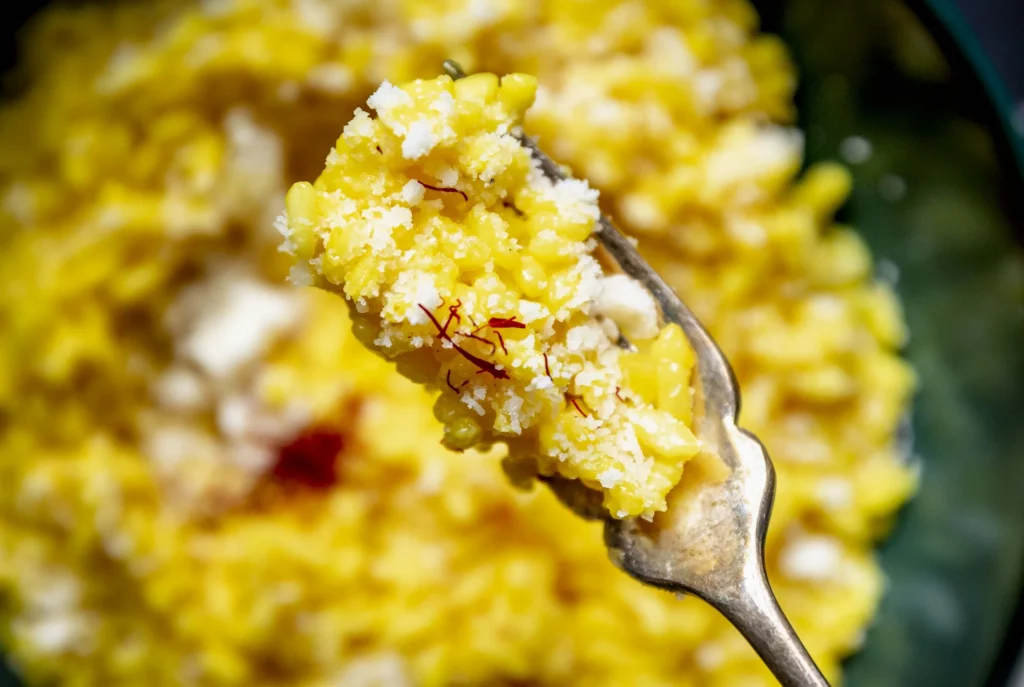
What is Risotto Milanese made of?
This very old recipe used to be made with some ingredients that are not commonly used nowadays: rice, onion, meat broth, Parmigiano Reggiano cheese, butter, saffron, and bone marrow, the latter which I never use even though some of the more traditional restaurants in Lombardy still add it.
The key ingredient is saffron which is used as both a natural seasoning and coloring agent thanks to its bright orangish coloring. You only need to use a little saffron as it is very expensive, but definitely use it because it greatly enhances the flavoring of this dish.
What kind of rice do you use for Risotto Milanese?
Look for only top-quality rice such as Arborio or Carnaroli. Arborio rice fits this recipe best as its short, white grain will absorb a significant quantity of liquid without losing its compact texture.
This recipe belongs to my grandma, nonna Marianna, who was a fantastic cook. Her dishes were full of flavor and very rich. Her specialty was her authentic risotto with saffron from Lombardy. This is a lighter interpretation of the well-known traditional recipe.
Risotto Milanese with saffron and Parmesan
Ingredients
- 2 cups of Arborio or Carnaroli rice (180g)
- a pinch of saffron threads (15-30g)
- 1 small onion
- 1/2 glass of dry white wine
- 4 1/2 cups of vegetable or meat broth
- 1/2 cup of grated Parmigiano Cheese (40g)
- 1/2 cup of butter (125g)
- Salt and pepper to taste
Instructions
- Steep the saffron threads in 4-5 tablespoons of hot water in order to release all of their aromatic properties for at least 10 minutes. Longer is better;
- Bring the stock to a boil. Keeping the stock hot helps to coax the starch gently out of the grains of rice. Adding cold stock will keep the risotto from becoming creamy;
- In a heavy pan or stockpot, heat 2 tablespoons (40g) of butter over high heat and add the thinly sliced onion;
- Stir until softened (about 2 mins);
- When the onion is tender and translucent, lower to medium heat and pour in the rice stirring to thoroughly coat until they become toasted and translucent for about 2 minutes;
- Add the white wine and stir until it evaporates;
- Add the stock, 1/2 cup at a time, stirring constantly until it is nearly absorbed in between additions;
- Add the water with the saffron;
- After all the stock is added and you can see the bottom of the pot when you stir, remove it from the heat and stir in the remaining butter and the cheese;
- Serve it on a cold plate.
How do you know when your risotto is done?
Risotto usually takes about 20-30 minutes. It is done when it is compact but soft when chewing.
Keep in mind the following:
- Do not rinse the arborio rice like other kinds of rice.
- Cut down on the broth and reduce the cooking time if you like a more compact risotto, or increase it if you want it softer and creamier;
- If you added too much broth, increase the heat to make the liquid evaporate; be careful as the rice can stick to the bottom easily.
A perfect mantecatura makes your risotto delicious.
Mantecare means to cook until creamy: it is much more than stirring. You have to remove the pan from the heat and add some butter when the rice is done.
This is what you have to do:
- add cold butter which makes the risotto unforgettably creamy;
- add high quality grated cheese: Grana Padano or Parmigiano Reggiano.
- Remove the risotto from the heat, leave it to rest for a couple of minutes, and then add cold butter and the Parmigiano. Stir well and cover with a lid and let it sit for another couple of minutes;
- Be careful to stir it gently with a wooden spoon. This final operation makes the risotto more uniform and creamier.
- Serve it on a cold plate so that the grains don’t continue to cook.
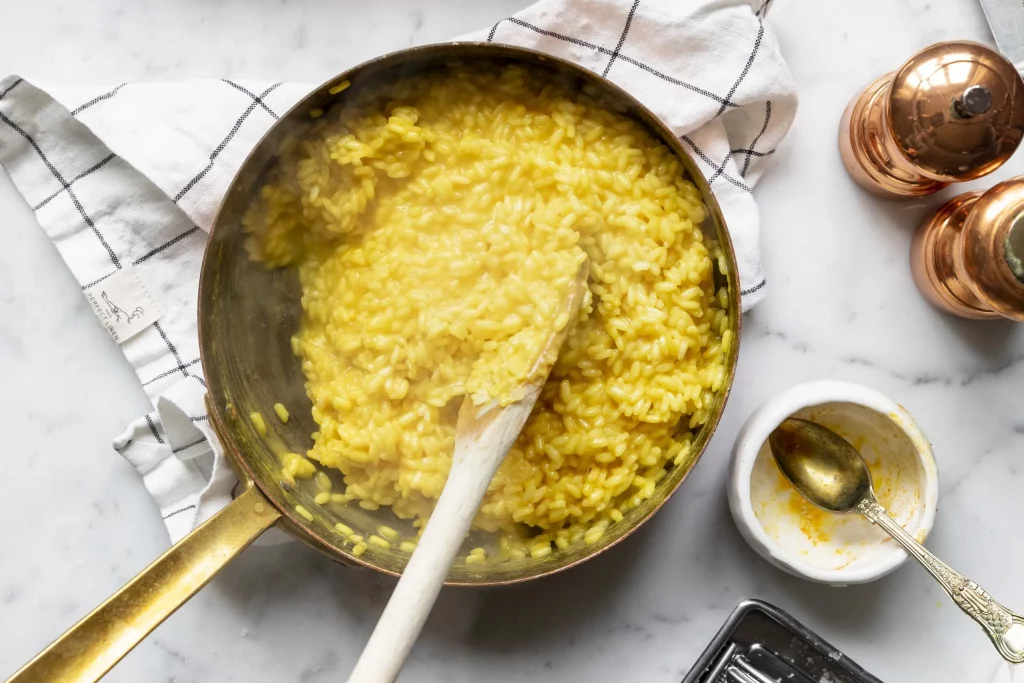
What can you serve risotto with?
Risotto is a dish you may enjoy on the weekend or on a holiday, so think about pairing it with a meat dish and cooked vegetables. For a fresher taste, combine it with a crisp salad, or raw vegetables.
Can you have risotto the next day?
Risotto is even better if eaten the following day. Heat the risotto in a saucepan and toast it a little; the crunchy texture will make it even more delicious. Risotto keeps for up to 2 days in the fridge in an airtight container.

